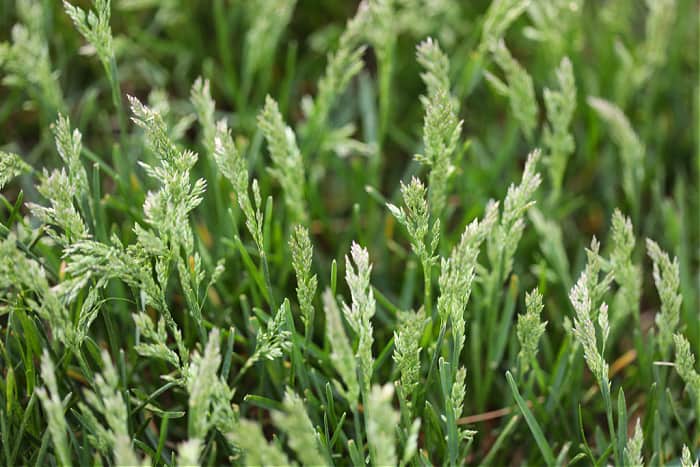Is your grass flowering? If so, follow these tips to keep your lawn healthy.
At some point during the spring season it’s very likely you’ll notice some flower heads forming along the top portion of your lawn. This can lead to a lot of confusion among do it yourselfers, especially if you’ve been properly maintaining your lawn. I usually get a steady wave of questions related to “Why is my grass flowering?”, from late May to mid June.
The answer is simple… It’s normal, and also temporary!
As much as I’m a perfectionist when it comes to my lawn, I’ve trained myself to accept this brief 3-4 week period when my grass is flowering. But, that’s not to say I don’t do what I can to minimize these unsightly flowers.
Let’s take a look at why your grass flowers and what you should do about it…
Why Does Your Grass Flower?
The reason your grass flowers is pretty simple. Your lawn is just like so many other plants in your landscape. In order to reproduce, it forms a flower, and then seed. In a naturally occurring situation, this seed eventually drops into the soil and grows into more grass. This is the way mother nature intended it to be.
But, chances are the lawn you maintain on your property doesn’t really fit into a ‘naturally occurring’ situation. More on this later (see section ‘Should You Let Your Lawn Go to Seed).
Poa Annua Vs Kentucky Bluegrass
If you’re seeing your grass flower, chances are you are either looking at Kentucky Bluegrass, or Poa Annua. The Kentucky Bluegrass is a desirable grass type, where as Poa Annua is considered an annual weed in most cases. You can tell the difference between the two by looking at the flower. Kentucky Bluegrass has dense flowers that tend to point up, where as Poa Annua has less dense flowers that point straight out. You can see a great, short video on the difference in the seed heads here: Poa Annua Vs Kentucky Bluegrass Identification.
The good news is if you are seeing Poa Annua mixed in among the rest of your turf you can address the problem by applying a pre emergent herbicide in late summer/early fall. This will block next years Poa Annua from emerging. Most homeowners will apply an early spring application of pre emergent, but it’s actually important to apply a pre emergent in early fall as well (as long as you aren’t doing any fall seeding). Check out this full lawn care program which nails down the timing of this late season pre emergent application: Lawn Care Program for Green Grass.
What To Do About Your Flowering Lawn
1. Mow High and Often- Resist the urge to mow low to try and chop off the flowers on your blooming lawn. Doing so will only stress your lawn more. Instead, mow high, and often. This is your best bet to minimize flower production.
2. Feed Your Lawn!- This is so important. When your lawn is producing flowers (going to seed) it uses a ton of energy. There’s no doubt it will be at a weakened state and will be more susceptible to natural stressors such as fungus, dry weather, heat, etc. This is a great time to feed your lawn with a healthy does of nitrogen. Nitrogen will actually help shift some of the focus back on blade growth instead of seed production.
A fertilizer such as Flagship 24-0-6 is a great choice for when your grass is flowering. It is rich in nitrogen (24%) and also contains some Potassium (6%), but the middle number Phosphorus is 0%. Phosphorus is most responsible in seed development and flowering which we are trying to prevent, so having that zeroed out during this time is a good thing. Learn more about what each Macronutrient does here: N,P,K Meaning
Just note, the Flagship 24-0-6 is just one suggestion. Don’t think you have to make a special purchase or steer off from the lawn care plan you have mapped out. Any fertilizer rich in Nitrogen is a good choice for a lawn that is flowering.
3. Keep Mower Blades Sharp- Your blades are cutting through a lot at this point in the season. Thick grass blades, thick stalks, and now flowers. This is a great time to get a good clean edge on your mower blade.
Should You Let Your Lawn Go to Seed?
It sounds like a brilliant plan doesn’t it. Just let your lawn go to seed and you’ll get beautiful, free grass seed and your lawn will naturally thicken up without you lifting a finger.
Of course, that awesome plan won’t work at all. You see, almost all grass seed you get these days is a hybrid. In other words it’s been genetically modified and the seed that the genetically modified grass produces is not viable. This seed is either sterile or will produce grass that is very different (and less strong and attractive) than the grass the seed came from.
Brown Tips On Grass Blades
During the weeks when your lawn is flowering, and ultimately going to seed, you may notice the tips of your grass blades look brown. What you’re most likely seeing is the seeds at the top of the grass stalks. As the seeds turn more of a tan color as seed production slows, you may notice brown “tips” throughout your lawn, even after a fresh mow. Again, this is normal and temporary.
Make sure your mower blades stay sharp at this time so you can be sure that the brown tips on your grass is actually from the seeds and not from a dull blade.
Check Out These Posts Next
Treating and Preventing Lawn Fungus
3 Product Lawn Care Program- Cool Season Lawns
Lawn Care Program for Warm Season Lawns
Top Dressing Lawn: Benefits and Advice
Lawn Dethatching: Everything You Need to Know
White Grubs: Prevention and Treatment
Follow Me
Join my free email list!
Plus, follow me on Facebook, Instagram, and Pinterest.



Here in Western NY state, some municipalities are supporting the “No Mow May” initiative to help the Bees! Got advice??
Personally, I could never imagine leaving my grass grow wild in front of my house during a time of year when the grass grows the fastest and needs the to be mowed the most. A lot of mowers would have trouble handling cutting grass that long too. Of course it’s personal preference but I prefer to have the bees enjoy my flower beds and other parts of my landscape. My lawn is for my daughter and dog to play on, and to add curb appeal.
Could you suggest a herbicide to treat for POA Annua and also Johnson grass?
My mower broke this spring after I mowed a couple of times. We were in a drought condition so only the new spring growth really took off. But I couldn’t mow for a month and the grass went to seed. The new mower didn’t have any issues cutting and mulching. July turned out to be quite wet and you should see all the new grass sprouting up.
I might do this every year.
Just a heads up the seed that comes from your grass is actually sterile so having that seed enter your lawn won’t grow grass. But I’m glad your lawn is looking good for whatever reason!